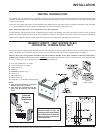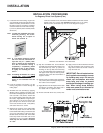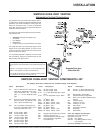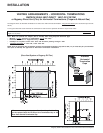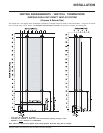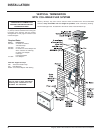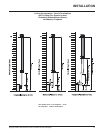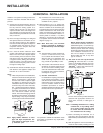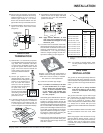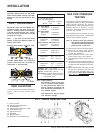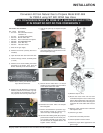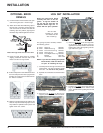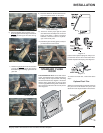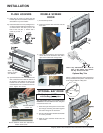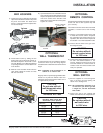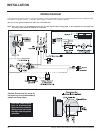
Regency P33R-2 Zero Clearance Rear Vent Direct Vent Gas Fireplace
19
INSTALLATION
GAS LINE
INSTALLATION
The gas line can be brought through either the
right or the left side of the appliance. The gas
valve is situated on the right hand side of the unit
and the gas inlet is on the right hand side of the
valve.
Note: If the gas line is being installed
from the left side, be sure to leave
room to accommodate servicing
of the fan.
The gas line connection may be made of rigid
pipe, copper pipe or an approved flex connec-
tor. (If you are using rigid pipe, ensure that the
valve can be removed for servicing.) Since
some municipalities have additional local codes
it is always best to consult with your local
authorities and the CAN/CGA B149 installation
code.
For USA installations follow local codes and/or
the current National Fuel Gas Code, ANSI
Z223.1.
When using copper or flex connectors use only
approved fittings. Always provide a union so
that gas lines can be easily disconnected for
servicing. Flare nuts for copper lines and flex
connectors are usually considered to meet this
requirement.
Roof Pitch Minimum Vent Height
Feet Meters
flat to 7/12 2 0.61
over 7/12 to 8/12 2 0.61
over 8/12 to 9/12 2 0.61
over 9/12 to 10/12 2.5 0.76
over 10/12 to 11/12 3.25 0.99
over 11/12 to 12/12 4 1.22
over 12/12 to 14/12 5 1.52
over 14/12 to 16/12 6 1.83
over 16/12 to 18/12 7 2.13
over 18/12 to 20/12 7.5 2.29
over 20/12 to 21/12 8 2.44
Dia. 4
Diagram 3: The upper half of the flashing is
installed under the roofing material and not
nailed down until the chimney is installed.
This allows for small adjustments.
Diagram 2
VERTICAL
TERMINATION
1) Maintain the 1-1/2" clearances (air spaces)
to combustibles when passing through ceil-
ings, walls, roofs, enclosures, attic rafter,
or other nearby combustible surfaces. Do
not pack air spaces with insulation. Check
pages 13-14 for the maximum vertical rise
of the venting system and the
maximum horizontal offset lim-
itations.
2) Set the gas appliance in its
desired location. Drop a plumb
bob down from the ceiling to the
position of the appliance flue
exit, and mark the location
where the vent will penetrate
the ceiling. Drill a small hole at
his point. Next, drop a
plumb bob from the roof to
the hole previously drilled
in the ceiling, and mark the
spot where the vent will
penetrate the roof.
3) A Firestop spacer must be installed in the
floor or ceiling of every level. To install the
Firestop spacer in a flat ceiling or wall, cut
a 10 inch square hole. Frame the hole as
shown in Diagram 2 and install the firestop.
Diagram 4
Note: Apply sealant "Mill-Pac" to inner
pipe and high temperature sili-
cone sealant to outer pipe on every
twist-lock joint.
pipe into the vent cap assembly. It is important
that the vent pipe extends into the vent cap
sufficient distance so as to result in a
minimum pipe overlap of 1-1/4 inches.
Secure the connection between the vent
pipe and the vent cap 3 sheet metal screws.
9) Install wall thimble in the center of the 10"
square and attach with wood screws
(Diagram 4).
4) Assemble the desired lengths of pipe and
elbows. Ensure that all pipes and elbow
connections are in the fully twist-locked
position and sealed.
5) Cut a hole in the roof centered on the small
drilled hole placed in the roof in Step 2. The
hole should be of sufficient size to meet the
minimum requirements for clearance to
combustibles of 1-1/2". Slip the flashing
under the shingles (shingles should over-
lap half the flashing) as per Diagram 3.
6) Continue to assemble pipe lengths.
Note: If an offset is necessary in the attic
to avoid obstructions, it is impor-
tant to support the vent pipe every
3 feet, to avoid excessive stress
on the elbows, and possible sep-
aration. Wall straps are available
for this purpose.
Galvanized pipe is desirable above the roof-
line due to its higher corrosion resistance.
Continue to add pipe sections through the
flashing until the height of the vent cap meets
the minimum height requirements specified in
Dia. 4 or local codes. Note that for steep roof
pitches, the vertical height must be increased.
A poor draft, or down drafting can result from
high wind conditions near big trees or adjoin-
ing roof lines, in these cases, increasing the
vent height may solve the problem.
7) Ensure vent is vertical and secure the base
of the flashing to the roof with roofing rails,
slide storm collar over the pipe section and
seal with a mastic.
8) Install the vertical termination cap by twist-
locking it.
Note: Any closets or storage spaces, which
the vent passes through must be en-
closed.
Diagram 1



